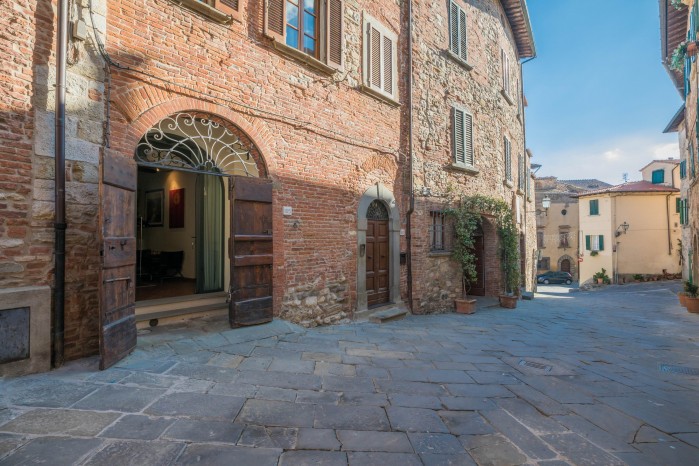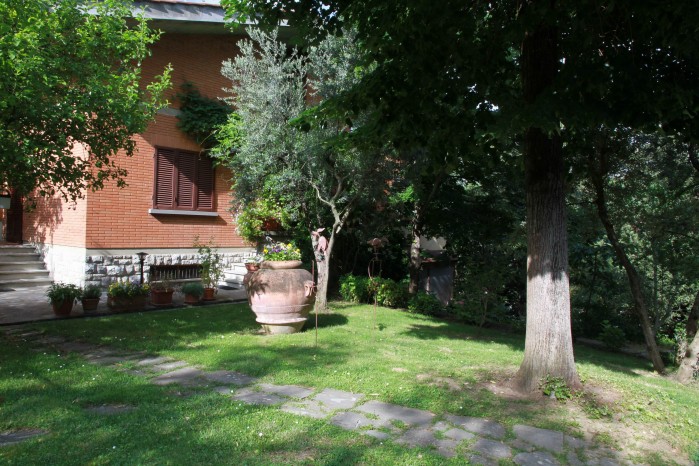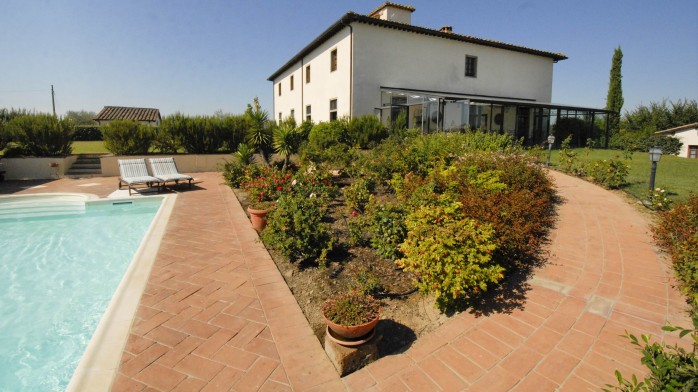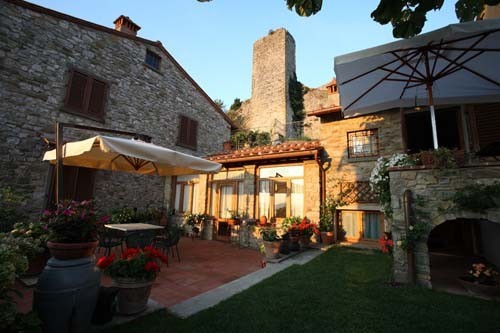Val di Chiana
A land whose origins date back to the Etruscans and whose hills and plains have during the centuries handed down to posterity many striking houses, recently restored and converted into beautiful apartments for rent in Val di Chiana. Like the Chianti, the Val di Chiana is one of the favourite places for tourists to spend their holidays. Cortona, Montepulciano, Chiusi have been for years a stunning place where to rent a villa in Tuscany, with beautiful landscapes, high culture and fine arts, as well as interesting archaeological sites and museums.
Val di Chiana, owing to its alluvial origin, has changed its morphology several times over the centuries. At first a fertile area, during the Etruscan dominance, it transformed into marshland, as a result of the inversion of the Chiana River’s course, to the extent that even the layout of the Cassia road had to be shifted farther upstream. Experts tried to solve the problem and even Leonardo was asked for a solution so that this land, wedged between Tuscany, Umbria and Latium might return to its ancient splendour. But it was not until the second half of the 19th century that the problem was definitively solved by the intervention of the celebrated hydraulic engineer Fossombroni. Consequently Val di Chiana has returned to be the highly fertile land it once was, a land that various memoirs refer to as a rich granary. The valley, in fact, looks like a huge chessboard with its fields of tobacco, vineyards (producing, among others, the celebrated Rosso di Montepulciano and Rosso Toscano), olive groves, maize and wheat. Much space is also set aside as pasture land for sheep, goats and cattle. The Chianina is, in fact, one of the oldest existing beef cattle breeds in the world, from which is produced the famous bistecca alla fiorentina.
However, the distinctiveness of this valley is to be seized from the combination of history, archaeology, nature, art, handicrafts and gourmet cuisine that one may find in visiting its villages.
A trip to Chiusi, for instance, is a voyage into the Etruscan world, one of the most mysterious ancient civilizations. Owing to the advantageous hill top position, looking over the area around Chiusi has been inhabited since the 11th century BC. The Roman writer Pliny writes “Porsena was buried below the city of Clusium in the place where he had built a square monument of dressed stones. Each side was three hundred feet in length and fifty in height, and beneath the base there was an inextricable labyrinth, into which, if anybody entered without a clue of thread, he could never discover his way out.” He continues describing the presence of no less than 14 pyramids, decorating the rest of the tomb.
Actually there is no other place where the Etruscan civilization survives more visibly than in Chiusi, which was in effect one of the most powerful among the Etruscan 12-city confederation. Nowadays the proud inhabitants boast about their origins and still celebrate their victory over Rome 2700 years before. Indeed, the thick necks, high cheekbones and sharp noses of the people walking nowadays on the cobbled street of Chiusi resemble those of the figures on the black and red vases studied so diligently by historians, anthropologists and students of art. Examples of these, and many other treasures, can be found in the Etruscan Museum, one of the most important repositories of this civilization in Italy. However, even the lowlands of Chiusi are a treasure trove of tombs, with 15 painted tombs, among which are simply a must "La Tomba della Pellegrina, della Tassinara, della Scimmia, and del Leone".
The splendid Medieval and Renaissance hill town of Montepulciano, called "the Pearl of the Cinquecento", has preserved its beauty intact. Going up the steep streets of its outlying districts, the visitor discovers beautiful palazzos and churches imbued with the unparalleled art of foremost Renaissance architects. The splendid Piazza Grande must be seen together with the Duomo, with its uncompleted façade, and the Palazzo Comunale, surrounded by Renaissance palazzos. Montepulciano is also a very lively cultural centre. The best known events are the International Art Workshop and the Bruscello, a popular amateur theatre performance whose ancient tradition is rooted in peasant life. Yet, this town is also a delight to the delicate palate: experience one of Italy’s best wines, the Vino Nobile, while savouring a dish of pici pasta (a thicker variant of the spaghetti) with duck sauce.
The medieval town of Cortona, was founded by the Etruscans, though legend claims it was Noah’s son Ham who established it. Like, Montepulciano, steep and narrow streets lead you around the town or to viewpoints embracing the whole of the Val di Chiana. The Palazzo Casali hosts the Etruscan Academy Museum, founded in 1727, with items also from Roman and Egyptian civilizations as well as art and artefacts from the Medieval and Renaissance eras. Among the most famous ancient relics is the famous bronze Etruscan hanging lamp. Other treasures are to be found in the Diocesan Museum, among which two panels by Fra' Angelico, an Annunciation and a Virgin with Child and Saints. The strength of the Renaissance ideal are to be found in the churches, Santa Maria Nuova, built by Giorgio Vasari in 1554, and in Santa Maria delle Grazie, with their centralized forms. On the hill are also to be found Etruscan chamber-tombs of slab construction, including the Tanella di Pitagora. An important, international event is held here every summer: the Tuscan Sun Festival, an annual music and lifestyle festival which balances evening musical programmes with daytime events such as art exhibitions, discussions with literary figures, as well as wellness and culinary sessions.
The Medieval, fortified hilltop village of Lucignano, with its maze of winding streets, remains intact to this day. Strategically located between Siena and Arezzo, Lucignano boasts splendid monuments such as the Rocca, close to the town walls, the fortress, attributed to Bernardo Puccini, the Sanctuary of the Madonna delle Querce, designed by Giorgio Vasari, the convent of the Cappuccini and the churches of Misericordia and della Collegiata. Of note is the giant reliquary of the Albero della Vita, the Tree of Life, a gilded and bejewelled tree surmounted by a crucified figure, which is preserved in the Municipal Museum housed in the 13th century Town Hall. Definitely a masterpiece of Siena’s goldsmiths.
Perched on a hilltop between Val di Chiana and the Valle dell’Asso, in a environment abounding in woods and cultivated vineyards and olive groves is the medieval village of Trequanda with the sturdy stone tower of its 13th century castle. Travertine gates dot the remains of the original wall, while from Piazza Garibaldi one has access to the remains of the castle or to the beautiful Romanesque church of Saints Peter & Andrew which hosts works attributed to Il Sodoma and Andrea Sansovino. Described as the village where time has stopped.
The lakes of Chiusi and of Montepulciano are known in Val di Chiana as the Chiari, (lights). Your glance eastwards will be captivated by the silver glimmering of the two lakes, two little stretches of water placed in the middle of the countryside. They are quite small and shallow but their effect on the ecosystem of the whole area is considerably patent. Exploited for its fish, nowadays they are considered natural areas where very rare flora and fauna find their ideal habitat. Enjoy a silent row in one of the characteristic boats and discover hidden corners. The sudden emotion of spotting a red heron or tiny egret flying high will reward a patient wait.


















